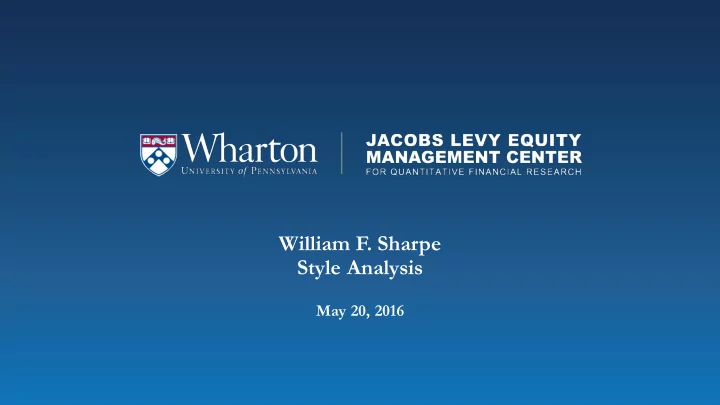

William F. Sharpe Style Analysis May 20, 2016
A Multi-factor Model Factors: Returns on mutually exclusive and exhaustive market capitalization-weighted portfolios
U.S. Stock Indices
Barra U.S. Stock Index Performance
Regression Analysis
Regression Analysis with a Constraint
Quadratic Programming
“An Algorithm for Portfolio Improvement” Advances in Mathematical Programming and Financial Planning, 1987
Asset Classes “ Determining a Fund's Effective Asset Mix” (Dec. 1988)
In-sample R2 Values 388 Pension Fund Manager Accounts
Asset Classes “Asset Allocation: Management Style and Performance Measurement” Winter 1992
R2 = 89.0 %
Mean: 0.18 %/mo Standard Deviation = 1.48 %/mo t(avg) = 0.84
Mean: 0.57 %/mo Standard Deviation = 1.05 %/mo t(avg) = 3.76
Mean = -0.074 %/mo (annualized: 0.888% /year)
Style and Performance Analysis l Performance in month t vs. Style at end of month t-2 l Out-of-sample R2 values l Style Analysis - number of months utilized - exponential weighting of monthly observations l Aggregate results for individual funds
A Large Pension Fund
Holdings-based vs. Returns-based Style Analysis Models (from Morningstar website) Holdings-based - Uses characteristics of underlying securities Returns-based - More widely used among financial professionals, because the input data (monthly returns) is ( sic ) widely available Morningstar has long been a proponent of holdings-based style analysis but recognizes that there may be situations where returns-based analysis can also be helpful. The company's institutional research platform … combines advanced holdings-based and returns-based style analysis. Ideally, practitioners should use both approaches.
Recommend
More recommend